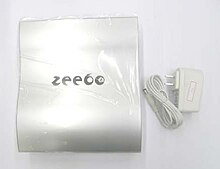 A Zeebo console wrapped in plastic and its power connector | |
| Manufacturer | Zeebo Inc. |
|---|---|
| Product family | Zeebo |
| Type | Home video game console |
| Generation | Seventh generation era[1][2][3] |
| Release date | |
| Lifespan | 2009–2011 |
| Introductory price | R$ 499,00 |
| Discontinued | |
| Media | Digital distribution |
| CPU | ARM11 based system on chip clocked at 528Mhz |
| Storage | 1 GB NAND flash |
| Graphics | ATI Imageon |
| Controller input | 6-button dual analog gamepad |
| Connectivity | 1 SD card slot 3 USB 2.0 ports 2G GPRS |
| Online services | ZeeboNet on Claro 3G (Brazil) Telcel (Mexico) |
The Zeebo is a discontinued home entertainment and education system from Zeebo Inc. It enabled users to play video games, and also connect to the Internet using its 3G modem, communicate online and run educational applications. The Zeebo was targeted at developing markets such as Brazil and Mexico.[4][5][6]
Zeebo was founded by Reinaldo Normand in 2008, based on a working prototype developed by Dave Durnil and business plan by Mike Yuen at Qualcomm. The company's stated intention was to create an affordable console with inexpensive games and educational content delivered via wireless digital distribution to circumvent piracy.[7] The Zeebo does not use DVDs or cartridges; games and other content are downloaded wirelessly over broadband cellular networks.[8] In addition to games, the Zeebo system also provides Internet connectivity, enabling users to access educational and information content, communicate via e-mail and do social networking (this capability was supported in Brazil and Mexico).[9][10][11]
Before its discontinuation, Zeebo had attracted content from companies such as Activision, Capcom, Digital Chocolate, Disney Interactive Studios, Electronic Arts, Fishlabs, Flying Tiger, Gamevil, G-Mode, Glu, id Software, Limbic Software, Namco, Polarbit, Popcap, Twelve Interactive and Vega Mobile.[12][13][14][15][16]
- ^ "The Zeebo game console: Why it matters". June 1, 2009. Archived from the original on August 10, 2012. Retrieved October 27, 2009.
- ^ Ho, Victoria. "Zeebo - the fourth game console? - ZDNet". ZDNet. Archived from the original on September 26, 2013. Retrieved September 22, 2013.
- ^ Ralph, Nate (March 25, 2009). "GDC: Zeebo To Bring Gaming to Emerging Markets". Wired. Archived from the original on October 30, 2013. Retrieved March 12, 2017.
- ^ "Zeebo, console da Tectoy, quer competir com o PS2" (in Portuguese). Archived from the original on February 29, 2012. Retrieved November 12, 2008.
- ^ "Zeebo Takes Wireless Gaming to Emerging Markets". Archived from the original on January 9, 2010. Retrieved October 27, 2009.
- ^ "Zeebo History In Brief". Archived from the original on May 25, 2010.
- ^ "Zeebo Inc. Fact Sheet" (PDF). Archived from the original (PDF) on April 4, 2010.
- ^ "Invisible network concept helping Zeebo make a serious business out of wireless games". Archived from the original on July 11, 2009. Retrieved October 27, 2009.
- ^ "Zeebo Partners with Opera to Bring the Internet Café into Emerging Market Living Rooms" (PDF).[dead link]
- ^ "Zeebo é lançado oficialmente no Brasil" (in Portuguese). Archived from the original on February 29, 2012. Retrieved May 25, 2009.
- ^ "Console de videogame Zeebo ganha acessórios e acesso à web" (in Portuguese). IDG Now!. Archived from the original on September 6, 2010.
- ^ "Gigantes do mercado de jogos credenciam Zeebo" (in Portuguese). Archived from the original on February 29, 2012. Retrieved November 12, 2008.
- ^ "Zeebo: entrevista com Reinaldo Normand, da Zeebo Inc" (in Portuguese).[dead link]
- ^ "Youtube: Tectoy Digital Video Presentation". YouTube. Archived from the original on July 8, 2017. Retrieved December 2, 2016.
- ^ "Innovative Independent Publishers and Developers Bringing New Content to the Zeebo Platform" (PDF).[dead link]
- ^ "Disney Mobile to Launch Popular Games on Zeebo System". Newswire. Archived from the original on January 11, 2011. Retrieved September 1, 2010.